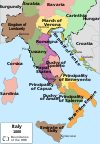Vitiges

Vitiges or Witiges (died 540) was king of the Ostrogoths in Italy from 536 to 540.[1]
He succeeded to the throne of Italy in the early stages of the Gothic War, as Belisarius had quickly captured Sicily the previous year and was currently in southern Italy at the head of the forces of Justinian I, the Eastern Roman Emperor.
Vitiges was the husband of Amalasuntha's only surviving child, Matasuntha.[2] The panegyric upon the wedding in 536 was delivered by Cassiodorus, the praetorian prefect, and survives, a traditionally Roman form of rhetoric that set the Gothic dynasty in a flatteringly Roman light.
Soon after he was made king, Vitiges had his predecessor Theodahad murdered.[3] Theodahad had enraged the Goths because he failed to send any assistance to Naples when it was besieged by the Byzantines, led by Belisarius.
Justinian's general Belisarius took both Vitiges and Matasuntha as captives to Constantinople,[4] and Vitiges died there, without any children. After his death, Matasuntha married the patrician Germanus Justinus, a nephew of Justinian I by his sister Vigilantia.[5]
References
- ^ Edward Gibbon; Henry Hart Milman (1880). The History of the Decline and Fall of the Roman Empire. Harper & brothers. p. 271.
- ^ Julius von Pflugk-Harttung; John Henry Wright (1905). The great migrations. Lea brothers & company. p. 374.
- ^ John H. Rosser (2012). Historical Dictionary of Byzantium. Scarecrow Press. p. 458. ISBN 978-0-8108-7567-8.
- ^ John Stevens Cabot Abbott; Wilfred C. Lay (1900). Italy. P. F. Collier. p. 424.
- ^ Robert Rix (13 November 2014). The Barbarian North in Medieval Imagination: Ethnicity, Legend, and Literature. Taylor & Francis. p. 51. ISBN 978-1-317-58968-6.

